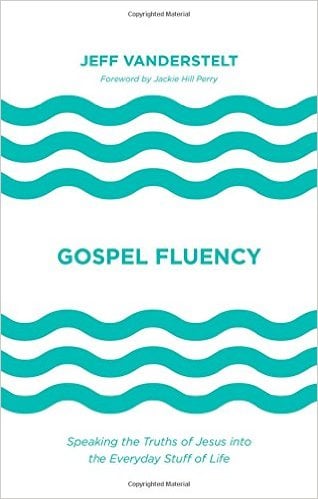⏱️ Estimated Reading Time: 4 min read
Go around the circle at your small group this week. Ask the folks on your staff and leadership team. Pitch this question to your spouse or your children, “Have you talked to someone about Jesus this week?” When we’re not stretching the truth or embellishing, most of us reply, “No.”
There are many reasons why we may reply in the negative. Maybe our work environment doesn’t lend itself towards opening up about our faith. Maybe we haven’t spent much time with people that given week. But I think the prevailing problem is that even in moments of opportunity to speak the truths of Jesus over coffee, over the copier, or over the dinner table, we simply don’t know how. We speak “Gospelish.” We are not conversational Christians. Truth be told, there are a thousand different models for evangelism and discipleship out there. But you can’t draw having a gospel-fluent conversation on a napkin, and that is Jeff Vanderstelt’s point.
In Gospel Fluency, Vanderstelt seeks to build on his first book Saturate by helping Christians now think through cultivating and practicing this lesson in fluency. “I believe such fluency is what God wants his people to experience with the gospel. He wants them to be able to translate the world around them and the world inside of them through the lens of the gospel” (41). This book is a Swiss Army Knife of a tool; it is a multi-faceted look at how we go about giving people Jesus. To not do so, after all, is to fail our very mission, as Vanderstelt points out (29).
In Part One, Vanderstelt casts his vision for a gospel-fluent church and people, a compelling and inspiring conviction for conversational Christianity founded and rooted in the gospel. Part Two, Vanderstelt presents the explicit gospel message and its makeup; narrated by the story, and climaxing in its message of salvation and faith. Part Three moves the conversation toward how this great gospel works in us, then with us (Part Four), then to others (Part Five). It is a comprehensive examination of top-down discipleship, beginning with the truths of Scripture and permeating into the roots of life, community, and mission.
Many of you reading this review probably already own at least a dozen books on discipleship. Why another one, you ask? First, let me reiterate that what Jeff is more interested in giving readers than methods, graphs, and drawings is giving them Jesus. “Belief in the gospel,” after all, “is an ongoing expression of our ongoing need for Jesus” (67). Vanderstelt helpfully takes us to the very ground level and majors on telling stories from his own experiences, to demonstrate how gospel fluency manifests itself in real life. After reading this book, I want my small group to look different, to think different, to feel different. I want my discipleship meetings with folks in my church to have a different function and purpose. I want to give people Jesus. That’s what I told myself I was doing before, but after reading Gospel Fluency, I realize that there is much work to be done if I ever hope to make disciples the way Christ called me to.
It is easy to read a book review and come to the end and be utterly unsurprised that the reviewer is recommending the book. I don’t want my endorsement of this book to strike you as a formality; I truly believe this book, when read and applied carefully, can be one of the most powerful discipleship tools at our disposal. I’ve already used multiple principles and practices in this book in the short time since I finished reading it. It is a book I know I will return to again and again, and will definitely commend to friends, pastors, and small group leaders. It doesn’t matter what your position or level of “gospel fluency” is – read and re-read this book. You’ll be glad you did. I am so grateful to Jeff Vanderstelt for this wonderful, fresh, accessible volume. It has helped me tremendously.




